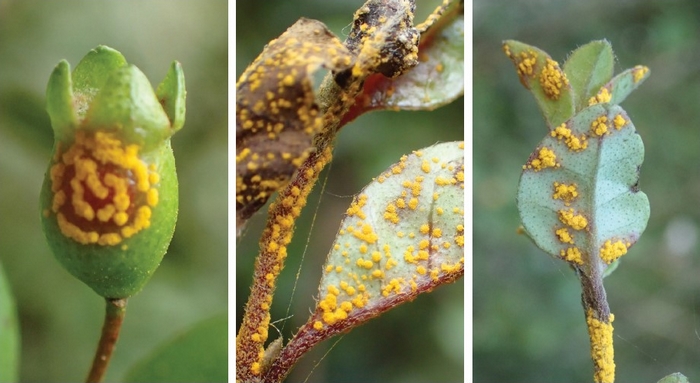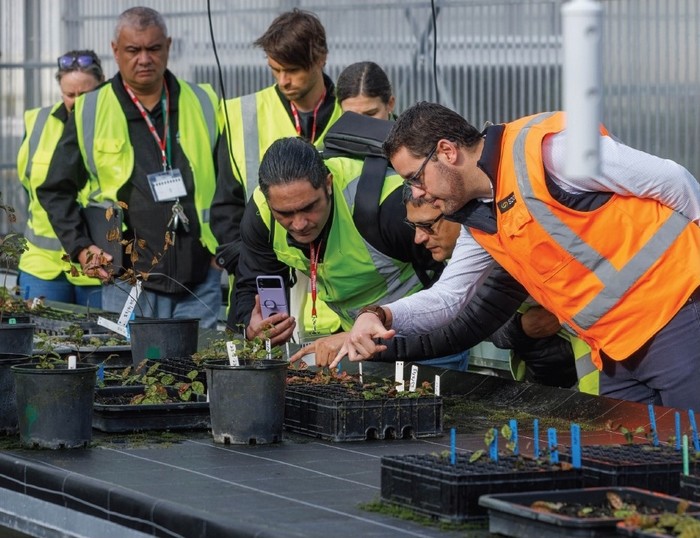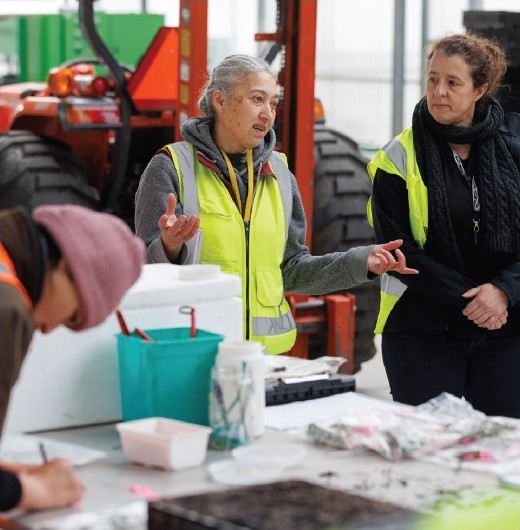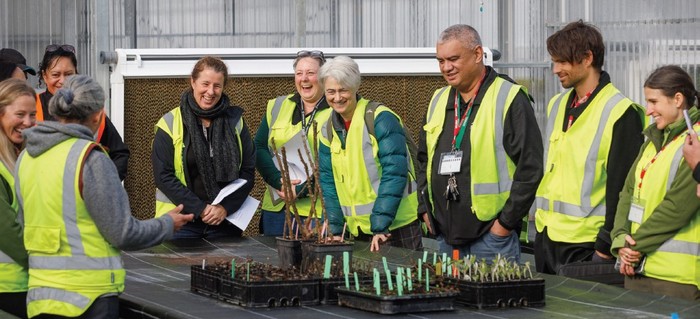Protecting native taonga
Conservation efforts step up to protect vulnerable species from myrtle rust.
Scientists and a Jobs for Nature team are in a race against time to save vulnerable native species under threat from myrtle rust in the Rotorua lakes area.

With fears mounting that species endemic to New Zealand could be wiped out by the fungal disease, researchers will be collecting more crucial data over summer to understand its spread.
But this research is more than just data collection; it’s a powerful study of resilience and nature’s battle for survival.
The full impact of myrtle rust on the health of ramarama, rōhutu and their hybrids was revealed over spring and summer in 2022-23. This followed efforts to identify species populations around lakes Rotoiti, Rotomā and Okataina by the Scion-led Myrtle Rust Jobs for Resistance programme – Te Rātā Whakamaru.
This summer researchers are extending the programme to include more sites around Rotorua and, for the first time, mapping populations of pōhutakawa, northern rātā and maire tawake (Swamp Maire).
Climate change casts a long shadow over this research. As temperatures rise and conditions shift, the prevalence of myrtle rust on vulnerable native species is expected to follow suit. The next phase of the three-year programme aims to anticipate these changes by revealing locations around the Rotorua lakes where target species comes under the most disease pressure.
New sites for monitoring include Whakarewarewa Village and potentially Mokoia Island, providing researchers with the unique opportunity to study the impacts of myrtle rust in different environments, such as those with geothermal activity.
“Researchers have never explored how myrtle rust behaves in a geothermal environment, so this study is set to generate valuable new insights,” Scion forest pathologist Darryl Herron says.
Scion is planning to combine satellite imagery with deep learning AI technology to map populations of pōhutakawa around the lakes before using the Te Tira Rātā (field work team) to confirm and validate the data from the ground.
Dr Tanya Robinson, Manahautū general manager for Whakarewarewa – Living Māori Village, says they are very happy to support the research.
“We are so pleased to be able to tautoko this kaupapa and the work of the team, as they study the effects of geothermal activity on myrtle rust and map out the populations of pōhutakawa.
“We know this will benefit taonga rākau in the village, and we’re also keen to see how the project grows and passes on great benefits for many different roopu and rohe across the motu. Our manuhiri and education programmes will also benefit, as we encourage our kaiarahi guides to be sharing information on this important programme and the work of Te Rātā Whakamaru.”

Breeding for resistance
As well as monitoring sites for signs of myrtle rust, work will continue on nurturing the cuttings of ramarama, rōhutu and their hybrids taken from the field over winter. The cuttings have been propagated in Scion’s nursery in the first stage of a long-term resistance breeding programme.
Herron says myrtle rust’s spread over 18 months had created a sense that conservation efforts were at a critical stage. “The population size of Lophomyrtus trees around the lakes area is quite small, and without any interventional management, we’re likely to lose them completely.
“With myrtle rust impacting these populations, we’ve realised how important it is to propagate cuttings before myrtle rust decimates them and we lose all access to their fruit or seeds in the future.”
Ramarama, rōhutu and their hybrids belong to the Lophomyrtus genus and are part of the myrtle family that is at risk from the infectious airborne fungus. Regular field visits have confirmed the presence of myrtle rust in targeted populations and an overall decline in tree health.
Where myrtle rust was found in 2022-23, Te Tira Rātā (field work team) identified parts of the tree that were most affected and how the disease was impacting its reproduction.
“The disease targets new leaf growth,” Herron says. “If a tree is constantly impacted by myrtle rust it will start to die back and eventually it will stop producing fruit or seeds that would usually fall to the ground. You’ll see fewer young saplings emerge and those that do are vulnerable to infection – that’s when you stop getting natural regeneration in the forest.”
Engagement with mana whenua
Te Rātā Whakamaru started in April 2022 and is delivered in partnership with Rotoiti 15 trust. It is funded by Jobs for Nature/Mahi mō te Taiao through the Department of Conservation – Te Papa Atawhai.
With support from Scion scientists, 10 full-time staff have been trained as field technicians and are employed to carry out surveillance work in Bay of Plenty native forests and at Scion.
Engagement with mana whenua has been a core part of the programme. Before cuttings of ramarama, rōhutu and their hybrids could be removed from the field, Scion and Te Rātā Whakamaru sought permission from hapū and explained how cuttings could be used to preserve the genetic diversity of the local populations and bred for myrtle rust resistance.
Project technical lead Dr Jacqui Bond says while the outlook for the species appeared dire, a positive has been the relationships built with mana whenua and the trust they have in the team to take cuttings.
Hōmiromiro (field technician) Otaki Grant says the message received from mana whenua is clear. “They don’t want to idly stand by and watch the species decline. Their permissions for us to take cuttings was pivotal in allowing the tree breeding phase to begin.”
Rotoiti 15 Trust chair Arapeta Tahana says mana whenua are deeply concerned about the impact myrtle rust is having on plant and tree species in Rotorua. “From a Māori world view, we are connected to nature, so these species are our family. Not only do we, as guardians, have an obligation to look after the natural world, but we also feel an innate obligation to look after our older brothers and sisters that came before us in the ngāhere. We see the trees as part of our whakapapa and identity, so we are very motivated to help them.”
Working in the forest was restoring lost connections with their whakapapa, and helping to unlock a sense of purpose for many employed in the Te Rātā Whakamaru programme, Tahana adds.
“Part of our journey as Rotoiti 15 is about reconnecting people to nature and letting them feel that love. Out of that builds a passion for conservation and that desire to find solutions.”

Developing new protocols
Herron says the team’s learnings could form the basis for cutting protocols that could be applied to other indigenous species as well. The long-term aim is to grow trees from cuttings and seeds that demonstrate a natural resistance to myrtle rust infection.
“It’s unclear why some trees are infected and others aren’t. Is it because the disease hasn’t reached them in the field, or is it because they have some tolerance? These are the questions we want to answer,” Herron says.
Another major challenge facing researchers is the time it takes to breed for resistance, as native trees grow very slowly compared with commercial species like radiata pine or eucalypts.
“It’s our hope that we identify some myrtle rust-tolerant individuals in the field and protect them by taking cuttings, propagating them and growing them into a tree,” Herron says. “Together with our partners, we hope to grow the seed, plant them and keep screening those individuals.
“As you do with traditional breeding, we’ll keep repeating that process to find the strongest and most disease-tolerant individuals. But this process requires a multi-year programme that will operate beyond the terms of what Jobs for Nature is currently funded for.”
The Te Rātā Whakamaru programme is funded by Department of Conservation – Te Papa Atawhai. It is among a suite of research involving more than 30 Scion scientists who have been working towards protecting our most vulnerable myrtle species from myrtle rust since the disease was discovered on mainland New Zealand in 2017.

